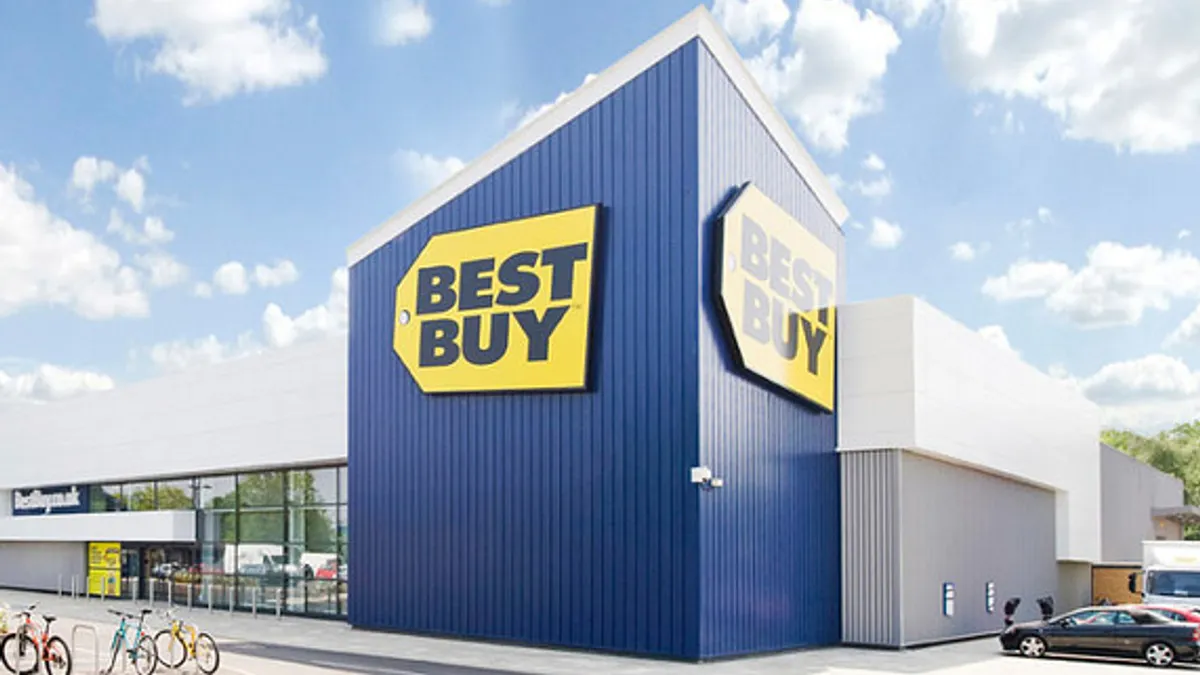Dive Brief:
-
Best Buy on Thursday reported that revenue rose 4.2% to $9.32 billion, but the company was hit hard (say $100 million hard) by the late introduction of the Apple iPhone X, which landed in the retailer's fourth quarter, and by hurricanes, which dragged down same-store sales by 15 to 20 basis points. Overall same-store sales rose 4.4%, missing the Thomson Reuters I/B/E/S projection cited by Reuters for a 4.8% increase.
-
U.S. revenue in the quarter rose 3.6% to $8.5 billion. Same-store sales in U.S. stores rose 4.5%, partially offset by losses of revenue from 10 large format and 44 Best Buy Mobile store closures, according to a company press release. U.S. e-commerce sales rose 22.3% on a comparable basis, thanks mostly to higher conversion rates and higher average order values, the company said. Online revenue's percentage of total domestic revenue rose 190 basis points to 12.7%, versus 10.8% last year, per the release.
-
From a merchandising perspective, the company generated growth across almost all categories, with the largest drivers of same-stores sales being appliances, computing and smart home, the company said. Best Buy raised its full-year revenue growth outlook to between 4% and 4.8% from its previous outlook of approximately 4% and raised its non-GAAP operating income growth outlook to between 7% and 9.5% from its previous outlook of between 4% and 9%, according to a statement from CFO Corie Barry.
Dive Insight:
Best Buy missed analysts' expectations for same-store sales, but CEO Hubert Joly shrugged that off, noting pressure from Apple's late iPhone release and the natural disasters that pummeled Texas, Florida, Puerto Rico and Mexico in the quarter.
"We are very excited about our plans for holiday, including a curated assortment of great new technology products, free shipping with no minimums and a range of new capabilities such as our new In-Home Advisor program, an updated gift center, and same-day delivery in 40 cities," Joly said in a statement. "We believe we are well positioned for a successful season and therefore, we are raising our financial outlook for the fourth quarter and for the year."
Moody's Investors Service agreed with Joly that the electronics retailer is in a good position to perform well in its all-important fourth quarter. Moody's Lead Retail Analyst Charlie O'Shea suggested the third quarter was actually pretty strong.
"Q3 was a very solid quarter for Best Buy on multiple fronts, with meaningful revenue growth and largely preserved margins in the midst of a highly-promotional environment, which reflect improved efficiencies as it executes its continued march towards becoming a true multi-channel retailer," he said in a note emailed to Retail Dive.
The key for the retailer heading into the holidays will in part be its ability to combat the increasing competition from Walmart and Amazon. Amazon in particular is shaping up to be a formidable foe in the electronics space, accounting for a whopping 90% of the $5.6 billion growth in consumer electronics sales posted nationwide in 2015, according to a note from Deutsche Bank analysts last year. Five years ago, Amazon had 6.2% share and ranked No. 4 on the list of top 100 U.S. electronics retailers; last year, the e-commerce giant landed at No. 2 with 17% share, jumping ahead of Walmart.
"As we head into the teeth of the holiday shopping season, the key for Best Buy to maximize its profitability and therefore success will be how well it manages its promotional cadence as Walmart and Amazon continue their heavyweight battle for market share across many categories, with consumer electronics a key battleground," O'Shea said.
Best Buy has indeed responded forcefully, which bodes well for its holiday sales. The retailer is clearly aware of the challenge from Amazon, according to data from Frank N. Magid Associates emailed to Retail Dive earlier this year, and enjoys some advantages. While customer traffic is lower, a larger average ticket size allows Best Buy to stay equal to Amazon and its stores have staying power within higher income segments, according to a note from Magid Senior Vice President of Retail Matt Sargent. A longer-term concern, however, is that Best Buy enjoys a low relative share compared to Amazon among younger generations. "As millennials 'age up' into higher income segments, Best Buy needs to figure out how to better attract this segment," Sargent said.
Best Buy was among the first to conquer ship-from-store fulfillment, which the company said has helped to cut costs and speed up deliveries. The electronics retailer was also out early with its holiday free shipping policy and other holiday promotions, and earlier this month announced a tie-up with Amazon's Alexa voice assistant.
"With online sales growth of over 22% on a substantial relative base, Best Buy has demonstrated its ability to effectively leverage its physical store base to continue to generate online traction as in-store pick-up is a critical factor behind this growth, and we expect this capability to continue to resonate with shoppers this season," O'Shea said.
This story is part of our ongoing coverage of the 2017 holiday shopping season. You can browse our holiday page and sign up for our holiday newsletter for more stories.














